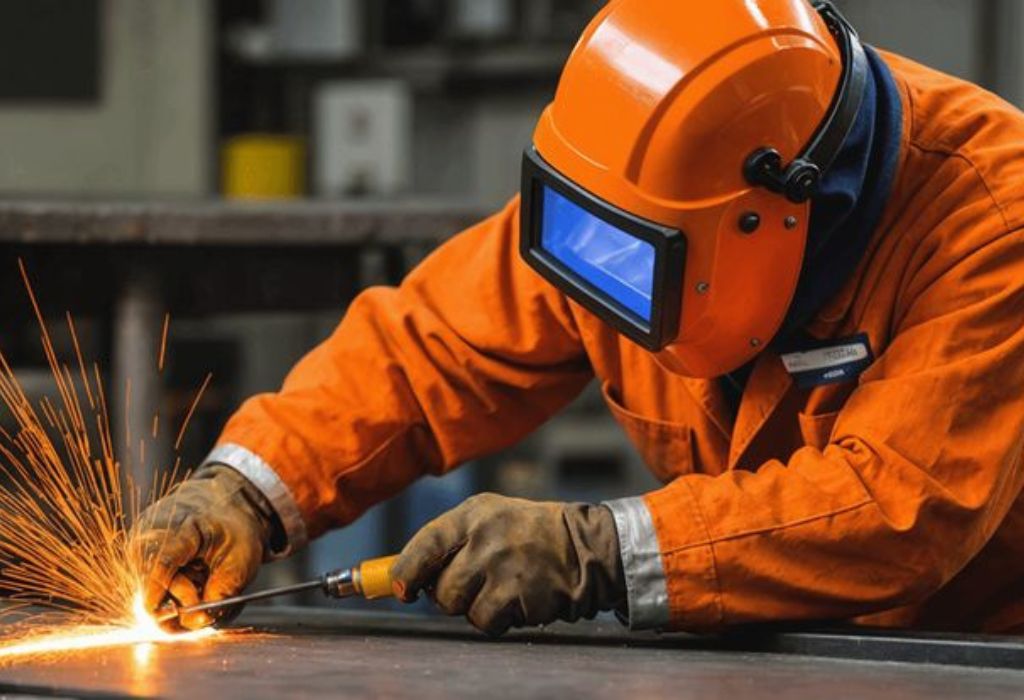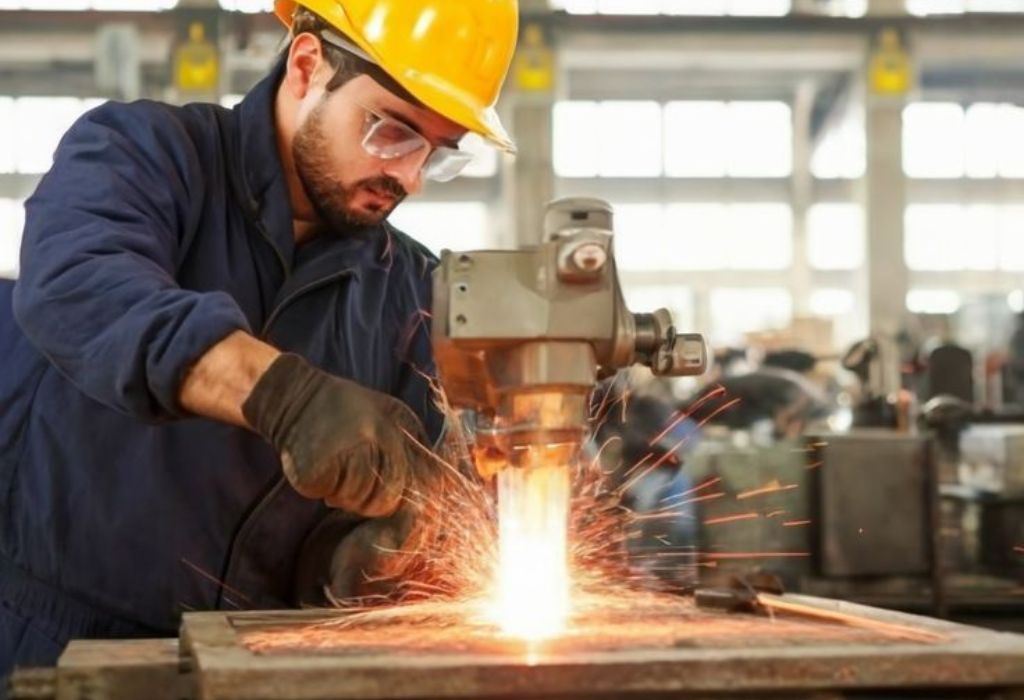A broken bracket lies in your hands. The nearest welding machine is miles away, yet the job cannot wait. Could an alternative method really fuse metal safely—without a traditional welder?
The question “can you weld without a welding machine” sparks curiosity for DIY makers. The promise: fuse parts using torches, chemical reactions, or clever pressure techniques. The catch: each method has trade-offs, risks, and hidden limits.
Many hobbyists reach for a propane torch or blend gas, hoping to mimic real welding. Yet true fusion welding requires extreme heat that most handheld tools cannot deliver.
At the same time, temperature thresholds matter: welding often exceeds 2,500 °F, while brazing typically lies between 800 °F and 1,500 °F. (Eastwood Garage)
Alternatives exist beyond brazing. Thermite welding, cold welding, or even emergency battery arcs make headlines in curious forums. But practical success demands knowing when each option works—and when it fails.
What “Welding Without a Machine” Really Means

The idea of joining metal without a welding machine often sounds impossible. Yet across workshops and home garages, makers have been finding creative ways to achieve strong metal bonds without electric arcs for decades.
When asking can you weld without a welding machine, the key is understanding the difference between true welding and metal joining.
True welding melts the base metal until it fuses into one solid piece. Joining, on the other hand, relies on adhesives, heat, or fillers that hold parts together without melting the base materials.
Gas flames, chemical reactions, or even friction can produce the heat needed to bond metal. The trick lies in controlling temperature, alignment, and safety so the result doesn’t crack or fail under load.
While processes like brazing or soldering might not meet industrial welding standards, they remain practical for small-scale repairs. For most DIY users, the goal is achieving a functional and durable joint, not aerospace-grade precision.
Different methods exist for different goals. A torch can melt filler metal for light jobs, while thermite reactions or cold welding serve specialized cases where electricity is unavailable.
Understanding these options empowers you to choose what fits your material, budget, and safety level before you strike a spark.
Does gas welding count as welding without a machine?
Yes. Gas welding uses a torch flame instead of electricity to fuse metal, making it a non-machine welding process.
Is brazing the same as welding?
No. Brazing melts filler metal but not the base metal, so it joins rather than welds.
Is cold welding possible at home?
Not realistically. It requires extreme pressure and precision equipment beyond typical DIY setups.
What about thermite welding?
Thermite welding uses a chemical reaction to produce molten metal and is often used for rail or heavy conductor joints.
Can you weld metal using a torch and rods?
Yes, for thin or moderate steel, a gas torch with filler rods can create strong fusion joints.
Oxy-Acetylene Gas Welding (No Electric Welder Needed)
When people ask can you weld without a welding machine, the most reliable answer lies in oxy-acetylene welding. This method uses a controlled mixture of oxygen and acetylene gases to produce an intense flame that melts metal and creates a true fusion weld.
The flame can reach temperatures around 6,300°F (3,480°C), hot enough to fuse steel and other ferrous metals. (ScienceDirect)
Because no electrical power is needed, gas welding is ideal for home users, remote sites, or workshops without access to arc welders. It’s also one of the oldest and most versatile welding techniques still in use today.
However, gas welding demands precision and respect for safety. Cylinders, hoses, and regulators must be properly maintained, and only trained users should light the torch. One small leak or improper setup can cause severe hazards.
For DIY repairs and small fabrication projects, oxy-acetylene welding can deliver clean, durable joints with minimal equipment. The skill lies in learning how to balance flame chemistry—too much oxygen burns the metal, too much acetylene creates weak joints.
It’s this control of fire and fusion that makes torch welding both challenging and rewarding for at-home metalworkers.
Is oxy-acetylene welding considered real welding?
Yes. It melts the base metal to create a true fusion joint, just like arc welding.
Is gas welding strong enough for repairs?
Yes, when done properly. Its strength depends on correct flame control and filler rod use.
What materials can you weld with a torch?
Steel, copper, and cast iron are common, though aluminum requires extra skill and flux.
Is oxy-acetylene welding safe for beginners?
It can be, provided all safety measures—flashback arrestors, PPE, and ventilation—are followed.
What are typical uses of gas welding at home?
Repairing metal furniture, gates, brackets, or light automotive parts where portability matters.
Brazing and Braze-Welding (Torch-Based Metal Joining)
When exploring whether you can weld without a welding machine, brazing often becomes the most accessible solution. It uses heat to melt a filler metal that flows between two pieces of metal, bonding them without melting the base metal.
Unlike traditional welding, brazing relies on capillary action rather than fusion. This makes it perfect for home use, since it requires only a propane or MAP-Pro torch instead of a high-temperature arc.
The filler metal, typically a brass or silver alloy, melts around 840°F to 1,500°F, far below steel’s melting point of 2,500°F. (Eastwood Garage)
This temperature difference makes brazing safer and more controllable for beginners. It also minimizes warping and distortion, common issues in full-heat welding.
Brazing works exceptionally well for repairing cracks, joining thin materials, or joining dissimilar metals like copper and steel. It’s widely used in plumbing, automotive restoration, and hobby metalwork.
To achieve a strong joint, the metal surfaces must be cleaned, flux applied, and uniform heating maintained until the filler flows evenly through the gap. Once cooled, the joint is solid, durable, and resistant to corrosion.
Though not as strong as a full fusion weld, brazing offers an ideal balance between ease, affordability, and reliability for DIY projects.
Is brazing the same as welding?
No. Brazing melts filler metal only, while welding melts both base metals.
Can you braze with a propane torch?
Yes. Propane or MAP-Pro torches can reach sufficient temperatures for most brazing jobs.
Do you need flux for brazing?
Absolutely. Flux removes oxidation and helps the filler flow smoothly into the joint.
Is brazing strong enough for heavy loads?
It depends. For non-structural parts, brazing is durable; for load-bearing parts, true welding is stronger.
Can brazing join different metals?
Yes. Brazing is ideal for joining dissimilar metals like copper, brass, and steel.
Emergency Battery Stick Welding (Field or Survival Method)
In rare situations, when power tools are unavailable, some DIY enthusiasts attempt battery stick welding to fuse metal. This unconventional technique connects multiple 12-volt car or truck batteries in series to generate enough current to create a welding arc.
When people ask can you weld without a welding machine, this is technically one of the few ways to do it electrically—without commercial equipment. But it’s risky and should only be used for emergencies, not as a regular practice.
The concept is simple but dangerous. Linking two or three car batteries produces roughly 24–36 volts, allowing a stick electrode to strike an arc, similar to a low-power welder.
While it can fuse mild steel in the field, the process lacks control over amperage, stability, and heat balance. One wrong connection can lead to battery explosions, burns, or damaged circuits.
In controlled setups, professionals sometimes use portable battery welding systems with built-in safety controls, but raw car batteries are never a substitute for real equipment.
Battery welding remains a fascinating example of innovation under pressure, yet it highlights the importance of understanding safety, current flow, and heat management before experimentation.
Can you really weld using car batteries?
Yes, but only in emergencies. Connecting multiple batteries in series can produce enough current to melt metal.
Is it safe to do at home?
No. Battery welding poses serious fire and explosion risks without protective gear or proper fusing.
What electrodes can be used with this method?
6010 and 6011 rods are commonly mentioned because they ignite easily on low voltage.
Can this replace a welding machine long term?
Never. The current is unstable and lacks control, leading to poor weld quality.
Who uses this technique responsibly?
Field mechanics, soldiers, or off-road repair crews who face emergency conditions away from power sources.
Thermite Welding (Chemical Heat, No Electricity Needed)

When considering can you weld without a welding machine, thermite welding often surprises people with its sheer power. This process uses a chemical reaction between aluminum powder and iron oxide to produce molten iron hot enough to fuse metal permanently.
The reaction temperature exceeds 4,500°F (2,500°C), making it one of the hottest non-electric welding methods available. (ScienceDirect)
Unlike torch or arc welding, thermite welding doesn’t rely on an external power source. Instead, once the reaction starts, it sustains itself and creates molten steel that flows into a prepared mold around the joint.
This technique is common in railroad maintenance, heavy conductor joining, and industrial fabrication, where portability and high-strength fusion are required. However, due to the high temperatures and handling hazards, it’s not suited for typical home use.
Thermite welding is proof that electricity isn’t the only way to achieve a true metal fusion. It’s incredibly effective but demands professional oversight, precise molds, and safety measures to control sparks and molten splatter.
For DIY enthusiasts, this process is better understood than attempted, offering insight into the chemistry of heat-based joining without machines.
Is thermite welding a real welding process?
Yes. It’s a true fusion method that melts and joins base metals using chemical heat.
Can thermite welding be done at home?
No. It involves extreme heat and requires professional-grade molds and safety gear.
Where is thermite welding used most?
In rail track joining, pipeline repair, and grounding conductor connections.
Does it require external electricity?
No. The exothermic reaction itself generates the heat needed for fusion.
Is it stronger than traditional welding?
Yes, thermite welds can achieve full-strength joints when performed correctly.
Conclusion
So, can you weld without a welding machine? The answer is yes—but the method you choose depends on your goals, tools, and safety precautions.
Oxy-acetylene welding and brazing are the most practical home options, providing solid joints without electricity. Both allow for strong, reliable connections when used with proper technique and preparation.
Methods like thermite or battery welding prove that fusion can occur without modern equipment, yet they demand serious caution and are unsuitable for casual use. Cold and friction welding show how advanced technology continues to evolve beyond traditional machines.
The key takeaway is understanding the process, not just the flame. Knowing how heat, filler, and pressure interact gives you control, whether working with a torch, chemical mix, or mechanical force.
Before starting any metalwork project, always prioritize safety—protective gear, ventilation, and clear surroundings can make the difference between success and disaster.
For small DIY tasks, brazing or gas welding offers a safe balance of accessibility and performance. For anything structural, professional welding remains the best choice.

I’m Darrell Julian, the founder, lead writer, and hands-on welding enthusiast behind ArcWeldingPro.com. With more than 15 years of real-world welding experience, I created this platform to share what I’ve learned in the field, in the shop, and in the heat of the arc.


